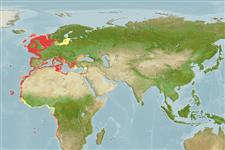Preferred temperature (Αναφ.
123201): 7 - 17.2, mean 10.2 °C (based on 645 cells).
Phylogenetic diversity index (Αναφ.
82804): PD
50 = 0.7500 [Uniqueness, from 0.5 = low to 2.0 = high].
Bayesian length-weight: a=0.01230 (0.01113 - 0.01359), b=3.03 (3.00 - 3.06), in cm total length, based on LWR estimates for this species (Ref.
93245).
Τροφικό Επίπεδο (Αναφ.
69278): 3.3 ±0.2 se; based on diet studies.
Ελαστικότητα (Αναφ.
120179): Μεσαίο(α), ελάχιστος χρόνος για διπλασιασμό πληθυσμού 1,4 - 4,4 έτη (K=0.3; Fec=36,000; tm=4).
Prior r = 0.47, 95% CL = 0.31 - 0.71, Based on 3 data-limited stock assessments.
Fishing Vulnerability (Ref.
59153): Moderate vulnerability (37 of 100).
🛈
Climate Vulnerability (Ref.
125649): Moderate vulnerability (41 of 100).
🛈
Nutrients (Ref.
124155): Calcium = 51.6 [28.4, 94.8] mg/100g; Iron = 0.873 [0.494, 1.476] mg/100g; Protein = 19 [17, 21] %; Omega3 = 0.394 [0.268, 0.583] g/100g; Selenium = 39.4 [20.0, 72.3] μg/100g; VitaminA = 12.9 [3.9, 37.7] μg/100g; Zinc = 0.742 [0.530, 1.043] mg/100g (wet weight); based on
nutrient studies. 